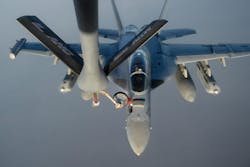PATUXENT RIVER NAS, Md. — U.S. Navy airborne electronic warfare (EW) experts are working together with the Boeing Co. and Northrop Grumman Corp. to upgrade the AN/ALQ-218 signals intelligence (SIGINT) system aboard the Boeing EA-18G Growler aircraft to provide the system with electronic attack capability.
Officials of the Naval Air Systems Command at Patuxent River Naval Air Station, Md., have announced a $24.4 million order to the Boeing Defense, Space & Security segment in St. Louis to provide airborne electronic attack system enhancements to the ALQ-218 receiver hardware and communication lines between assemblies to accommodate future planned functional growth and enhancements.
The AN/ALQ-218 from the Northrop Grumman Mission Systems segment in Baltimore is a passive sensor system that functions as a radar warning receiver, electronic support measures, and electronic intelligence.
The system provides airborne situational awareness and signals intelligence (SIGINT) by detecting, identifying, locating, and analyzing sources of radio frequency (RF) emissions.
Boeing is making upgrades to the U.S. Navy EA-18G Growler electronic warfare aircraft to enhance its offensive electronic-attack capability.
The AN/ALQ-218 is aboard the EA-18G electronic warfare (EW) jet and the P-8A Poseidon maritime patrol aircraft, and is being considered in the future for unmanned aerial vehicles (UAVs) and submarines.
The Navy EA-18G carrier-based electronic warfare aircraft carries multi-mode radar detection, suppression, and countermeasure equipment, such as the multiple AN/ALQ-99 radar jamming pods on its wing tips and tail, the AN/ALQ-218 EW receiver, and a communications countermeasures system installed in the plane’s gun bay.
Electronic warfare experts from Boeing and Northrop Grumman aim to provide upgrades and enhancements to communications among the Growler’s jammers and RF receivers to enable future capabilities like automatic jamming of enemy radar and communications systems quickly once detected.
The AN/ALQ-218 can operate on RF bands 0, 1, 2, and band 3, with pulsed and continuous-wave radar with optional communications support, while providing specific emitter identification. It offers enhanced fine frequency measurement to support electronic jamming.
The contract calls for Boeing to modify 13 sets of WRA-7, WRA-8, WRA-9, as well as 18 AEA gun bay pallets. Boeing also will write technical directives for the Navy and the government of Australia.
The Boeing EA-18G Growler is a specialized version of the two-seat carrier-based F/A-18F Super Hornet jet fighter bomber that is adapted for electronic warfare — specifically jamming enemy radar and communications, as well as attacking enemy radar installations with missiles that home-in on radar signals.
The Grower, which is replacing the Northrop Grumman EA-6B Prowler carrier-based EW aircraft, began production in 2007 and entered operational service in late 2009 with the U.S. Navy. The EA-18G aircraft are based at Whidbey Island Naval Air Station in Oak Harbor, Wash.
The growler is designed for suppression of enemy air defenses; stand-off and escort jamming; non-traditional electronic attack by integrating with ground EW operations; self-protect and time-critical strike support; and cost-effective technology insertion and system upgrades.
The Growler’s flight performance is like that of the F/A-18E/F Super Hornet, which enables the Growler to perform escort RF jamming as well as traditional standoff radar jamming and deception. The aircraft has more than 90 percent in common with the standard Super Hornet, sharing airframe, Raytheon AN/APG-79 AESA radar, and weapons like the AN/AYK-22 stores management system.
Most of the Growler’s EW attack equipment is mounted on the aircraft’s wing tips and in the space that on the Super Hornet houses a 20-millimeter cannon. The Growler has nine weapons stations for weapons and jamming pods.
The Growler’s EW gear includes the AN/ALQ-218 wideband receivers on the wingtips, and ALQ-99 high- and low-band tactical jamming pods. The ALQ-218 and ALQ-99 form an EW suite that provides detection and jamming against all known surface-to-air missiles. The aircraft is being readied for future threats with the Raytheon Next-Generation Jammer (NGJ).
The Growler can carry as many as five ALQ-99 jamming pods and two AIM-120 AMRAAM air-to-air missiles or AGM-88 HARM anti-radar missiles. It uses an interference cancellation system that allows radio voice communication during jamming.
The Growler has a crew of two, is 60 feet long with a 45-foot wingspan, and 16 feet high. The twin-engine jet can fly as fast as Mach 1.8, higher than 50,000 feet, and can fly 1,275 miles between refueling.
Boeing is the overall systems integrator for the EA-18G Growler combat jet. The plane’s electronic warfare equipment comes primarily from Northrop Grumman Corp. Its future Next-Generation Jammer equipment will come from Raytheon Co., and the jet’s onboard mission computers come from the General Dynamics Corp. Advanced Information Systems segment in Minneapolis.
On this order Boeing and its subcontractors will do the work in Baltimore; St. Louis; St. Augustine, Fla.; Bethpage, N.Y.; Patuxent River, Md.; and China Lake, Calif., and should be finished by December 2020.
For more information contact Boeing Defense, Space & Security online www.boeing.com/defense, Northrop Grumman Mission Systems at www.northropgrumman.com, or Naval Air Systems Command at www.navair.navy.mil.

